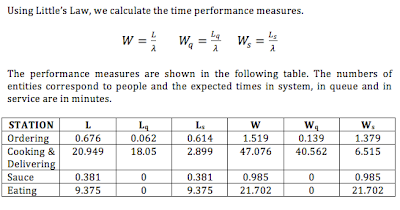For this week, we have to review other similar projects and find possible improvements for our project. Consulting three different blogs, we have the following conclusions:
Our system could have one extra station, corresponding to the trash. It means that the client, after eating his meal, goes to the trash and leaves the table clean, before getting away HAMBURGER. The routing probability of this station is one when the client comes from the "Eating Area" station. There are not arrivals from other stations to the "Trash" station.
Blog: http://hamburgueserias.blogspot.com/
The possible failures for our system are greater than we mentioned before. At the "Ordering" station, an additional set-up is that there is no more billing paper, and the cashier has to put it in the register. Another possible failure is that there is no change for the client and the cashier has to ask to the other server for exchange some money. Finally, it can appear a failure when the product that the client wants to order is not available in the system. Thus, the client has to think about another product in the menu.
Blog: http://e9-restaurantes.blogspot.com/
For our system, it is possible that a client arrives to the system and decide not to get in because the place is crowded. The decision is based on the number of people in queue. If the queue is apparently long, then the client prefers going somewhere else.
Blog: http://fastproyectb3.blogspot.com/
Our system could have one extra station, corresponding to the trash. It means that the client, after eating his meal, goes to the trash and leaves the table clean, before getting away HAMBURGER. The routing probability of this station is one when the client comes from the "Eating Area" station. There are not arrivals from other stations to the "Trash" station.
Blog: http://hamburgueserias.blogspot.com/
The possible failures for our system are greater than we mentioned before. At the "Ordering" station, an additional set-up is that there is no more billing paper, and the cashier has to put it in the register. Another possible failure is that there is no change for the client and the cashier has to ask to the other server for exchange some money. Finally, it can appear a failure when the product that the client wants to order is not available in the system. Thus, the client has to think about another product in the menu.
Blog: http://e9-restaurantes.blogspot.com/
For our system, it is possible that a client arrives to the system and decide not to get in because the place is crowded. The decision is based on the number of people in queue. If the queue is apparently long, then the client prefers going somewhere else.
Blog: http://fastproyectb3.blogspot.com/
The mentioned blogs were chosen according to the following reasons:
· The systems are based on a fast-food restaurant, where the speed of service is mainly important to improve customer service. That’s why restaurants avoid making their clients to wait for so long in line. Thus, it is expected that the number of clients in queue is minimal.
· The products that are offered are: hamburgers, salads, bakery products, French fries, and so forth.
· There is optional for the client to go to a particular station, because it depends on his willingness. For example, a costumer who does not want to get sauces, sugar, salt, etc. Or there is the possibility that he wants his meal to-go.
· Service takes place in two ways. First, there are people who take and deliver the order. Second, there is self-service for each client.
We hope you enjoyed our entry.
Thank you for reading us,
Nataly Patacón
Camila Fonseca
Fernand Malagón
Alejandro Moreno











